This is a Veteran Owned site

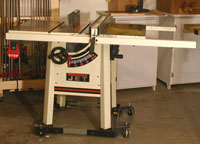 |
JET's new ProShop Saw is a major step up in the hybrid world and one that can save ne woodworkers the pain and money of buying ineffective cheaper saws on the way to one that actually works! Click image to enlarge |
JET JPS-10TS ProShop Saw
The hybrid concept done right
Text, photos & video by Tom Hintz
Posted – 5-23-2007
Several years ago table saw manufacturers conjured up the hybrid style of table saw – a loose combination of cabinet and contractor saw features. Unfortunately a large portion of the early hybrids were less than impressive to many woodworkers. JET did their homework and came up with the JET ProShop Saw, a machine that successfully embodies the hybrid concept and exceeds expectations in several areas.
Features
The key features of the JET ProShop Saw are the massive cast iron mechanism within the cabinet and the new fence design. The rest of the JET ProShop Saw is very well made and on its own represents a good value for the average woodworker. However, the innovation and quality of the mechanism and fence system when combined with its other features really make the JET ProShop Saw a true stand out.
Internal Mechanism
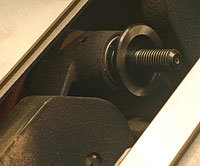 |
The massive cast iron mechanism and this very trick swing arm make this a very smooth running saw put the JET ProShop Saw head a shoulders over the competition. Click image to enlarge |
Replacing the traditional rod assembly found in most contractor style saws is a huge cast iron, horseshoe-shaped piece. This assembly also eliminates the hinged motor bracket that used to protrude from the rear of contractor saws and moves the 1 3/4HP TEFC (totally enclosed fan cooled) motor inside the cabinet. The horseshoe piece still connects to mounts bolted to the under side of the table but it eliminates a major source of flex and vibration. In addition to its rigidity, the pure mass of this new mechanism acts as a dampener to whatever vibration may remain. The result is an exceptionally smooth-running table saw that rivals high-end cabinet versions.
An intriguing feature of this mechanism is that the blade arbor resides in a heavy cast iron swing arm that separates the blade height adjustment from the tilt function in that only the swing arm moves when blade height is changed. The motor and the rest of the cast iron mechanism do not move up and down with it. The motor drives an idler pulley with a normal V-belt and a wide poly-V belt transfers the power to a machined pulley on the blade arbor. This dual belt drive contributes to an exceptionally smooth running blade despite it spinning at a stout 3600 rpm.
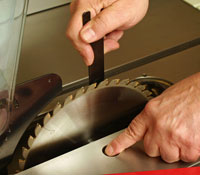 |
The pushbutton spindle lock makes changing blades easier and safer. Plus, it actually works! Click image to enlarge |
The arbor is 5/8”-diameter and long enough to support most dado blade sets at their full width. A dado insert is available for the JET ProShop Saw as an accessory.
The swing arm also houses a spindle lock, engaged by pushing a rubber-covered button on the table surface. This makes changing blades very simple and requires only one (included) wrench and a finger. Raise the blade fully (or the spindle lock will not engage), depress the button in the table surface and slowly turn the arbor. You will feel the lock click into its detent in the arbor shaft so you can loosen or tighten the blade nut as needed.
The JET ProShop Saw also has through the table adjustments for the 0-degree and 45-degree blade angle stops. Insert a hex wrench, dial in the stop to match an accurate square and you are done. Accuracy and ease of use in one system! If you have ever contorted yourself enough to reach blade angle stops hidden within a saw cabinet or housing, this feature will be welcomed and used far more frequently.
Real Dust Collection
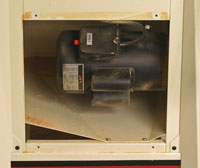 |
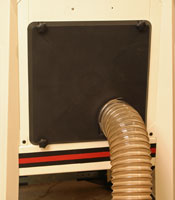 |
Moving the motor inside the cabinet (left) allowed JET to add a dust collection system that actually works! (See the video below) The result is a rear cover (right) that makes up a dust collection system that actually works. The small amount of dust left in the cabinet is largely due to the lack of vibration to shake it down the slope! Click images to enlarge |
|
Moving the motor inside of the cabinet housing allowed JET to add a real dust collection system to the JET ProShop Saw. A specially formed, angled floor panel directs the heavier dust down and to the rear where a 4”-diameter port is molded into the rear cover. That cover is held in place with four finger knobs to make getting into the cabinet for occasional cleaning easy and tool-free.
This dust system may work with a shop vac but it is obviously designed around a full-on dust collector. I used a JET DC1100 and found this dust system to be surprisingly effective. There was a small deviation which is spoken to later in the In The Shop section of this review.
ProShop Fence
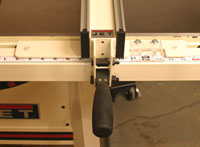 |
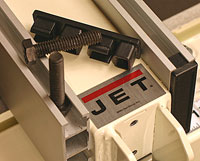 |
The ProShop fence is a true T-square (left) based on a steel tube with aluminum faces. (right) The groove along the top of the faces accepts common 1/4-20 hex head bolts that make attaching jigs simple and secure. Click images to enlarge |
|
An all new T-square style fence system is standard on the JET ProShop Saw. Based on a square steel tube and steel t-bracket, this fence locks onto the steel guide tube with a single lever that actuates an eccentric that secures the fence solidly with little effort. A magnified (adjustable side-to-side) cursor is built into the fence base over a scale with large, easy to read markings. The fence base has hex socket screws for adjusting the fence to the miter slot and the faces square to the table surface.
In place of the laminate-covered wood faces many fences use, the JET ProShop fence has a pair of extruded aluminum faces with smooth, straight faces. The top edge of both aluminum faces has a full-length groove that accepts common ¼-20 hex head bolts for attaching your shop-made jigs and fixtures. This is a very nice touch that you will appreciate in years to come.
Controls
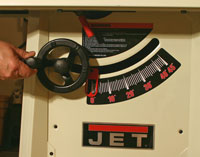 |
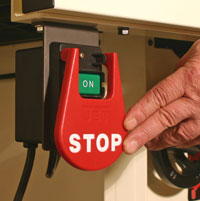 |
The blade height and bevel handwheels (left) are large and smooth operating. Even the bevel scale has been enlarged for easy viewing and accuracy. (right) The switch is easy to get at and the paddle can be "bumped" off with your leg. Click image to enlarge |
|
Blade height and bevel angles are operated with 6”-diameter handwheels, each with a spinner knob. Here again, the new mechanism shows itself in smooth, easy transitions in blade height and angle. The blade height wheel has the traditional locking knob at its center but the angle setting wheel is locked with a handle under the front edge of the table.
The bevel scale on the front of the cabinet has large, easy to read markings. Even the indicator is oversized and very easy to read accurately.
The On/Off switch, mounted to the left under the fence guide rail has a pushbutton for turning the saw on and a large paddle actuator for shutting it down. The paddle can be hand operated but is sized and placed so it can be “bumped” off with a thigh when your hands are full.
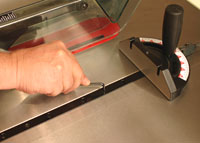 |
The miter gauge even has bar expanders to eliminate play in the miter slots! Click image to enlarge |
Miter Gauge
The JET ProShop Saw comes with a full-featured miter gauge that swivels to 60-degrees to either side with adjustable stops at 0 and 45-degrees. A large, comfortable handle both locks the fence and provides a safe grip for pushing the wood.
The guide bar has a disk at the tip to follow the T-shaped miter slots. The guide bar also has expansion adjusters with which to fine-tune its width to the miter slot to eliminate side to side play.
In the Shop
The overall fit and finish on the JET ProShop Saw is very well done. The table surface is finely ground and with a coat of paste wax (or your favorite table preparation) allows wood to slide easily and predictably. The miter slots are consistent in width and parallel to each other.
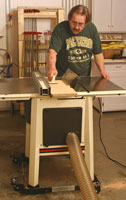 |
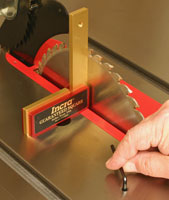 |
(left) Using the JET ProShop saw shows how smooth and powerful it is. Install a good blade and cuts are clean and accurate.
(right) Another user-friendly feature is the through the table blade angle stop adjustments. You will learn to love this! Click images to enlarge |
|
The JET ProShop Saw comes with the cabinet, motor and internal mechanism fully assembled. That leaves installing the legs (the saw comes upside down in its carton to make this easy) and then rolling it upright for final assembly. Installing the table wings, fence rails, switch, back cover and guide tube were done quickly with no problems encountered with fit or positioning.
I went through the complete alignment procedure using my MasterBar and MasterPlate as I do with every tool being reviewed. The blade checked out within 0.0015” of parallel to the miter slot. Finding a factory setting under 0.002” from perfect is remarkable. With the blade set at 45-degrees that error went to just under 0.003” so I left both alone. After setting up the fence and miter gauge the JET ProShop Saw was ready for use.
The 1 3/4Hp motor seems to have more power than expected. It powered through all of the hard and softwoods I tried without a whimper. Even full 45-degree beveled rips were made without noticeable strain or slowing of the motor.
What is most noticeable about the JET ProShop Saw in operation is the lack of vibration. The new cast iron mechanism and motor position seems to be at least partially responsible. Quality bearings and manufacturing make significant contributions to the lack of vibration as well. Whether ripping or cross cutting the JET ProShop Saw hummed along without protest.
See It Work! |
The dust collection system, when hooked to our JET DC1100 worked very well. Even with the standard throat insert there was little dust coming over the top of the blade. At the end of an afternoon of making various test cuts I opened the rear cover and discovered that most of the cabinet was free of dust. If there is a problem with this dust system it is that the slopped floor leaves a little dust in the corners near the front of the cabinet. This appears to be caused by the lack of sufficient vibration in the JET ProShop Saw to coerce it down the slope to the dust port. The amount left behind is minimal and you should be checking and cleaning this area once a month or so anyway.
The ProShop fence system is stable and thanks to the slider button at the rear, moves very smoothly across the table. While setting the fence up during assembly I tailed it away from the blade 0.002” at the rear. After a couple weeks of testing I rechecked the fence and found that it had moved less than half of a thousandth of an inch.
The square shape of the ProShop fence is nice for making jigs but the slots along the tops of the aluminum faces are VERY handy. Being able to make bolt-on jigs is more accurate and safer. This is a good idea that more manufacturers should consider adding.
Conclusions
The projected street price of around $1000 (5-22-2007) for the JET ProShop Saw may spook some new woodworkers but if the budget exists, it actually represents a better value. Too many of us worked through several table saw price ranges on the way to the saw we knew would work best in the first place. By combining attributes from their full-on cabinet saws with some of the economic features of their contractor line JET has brought a very capable machine to the market in a price range that makes it available to more woodworkers.
Whether you are brand new to the hobby and looking to get the best saw for your money or a veteran needing to take a step up, the JET ProShop Saw should be a must-see on your shopping list. I only wish this saw would have been available when I started “saving money” (yeah, sure) on table saws!
Have a comment on this review? –Email Me!
All written, photographic and drawn materials are property of and copyright by NewWoodworker.com LLC 2000-2019. Materials may not be used in any way without the written permission of the owner.

